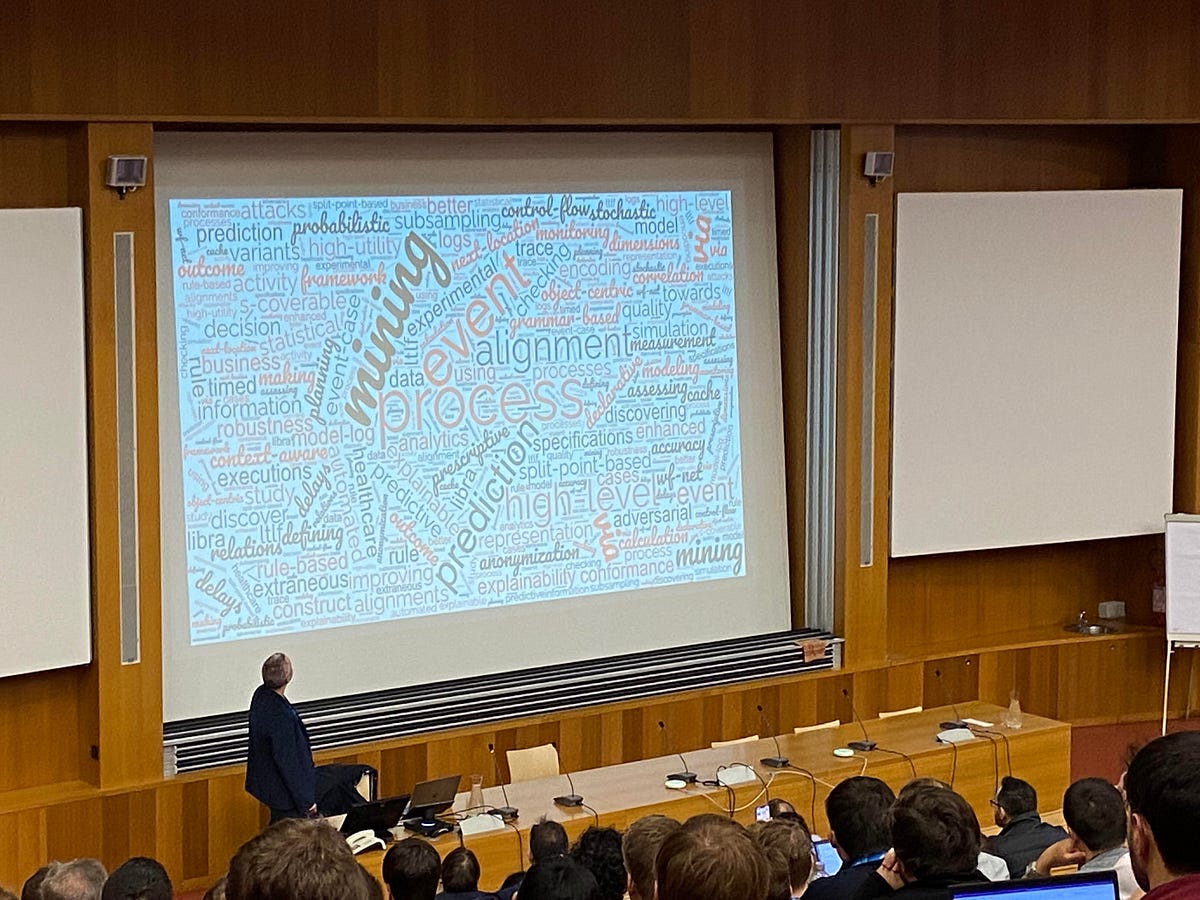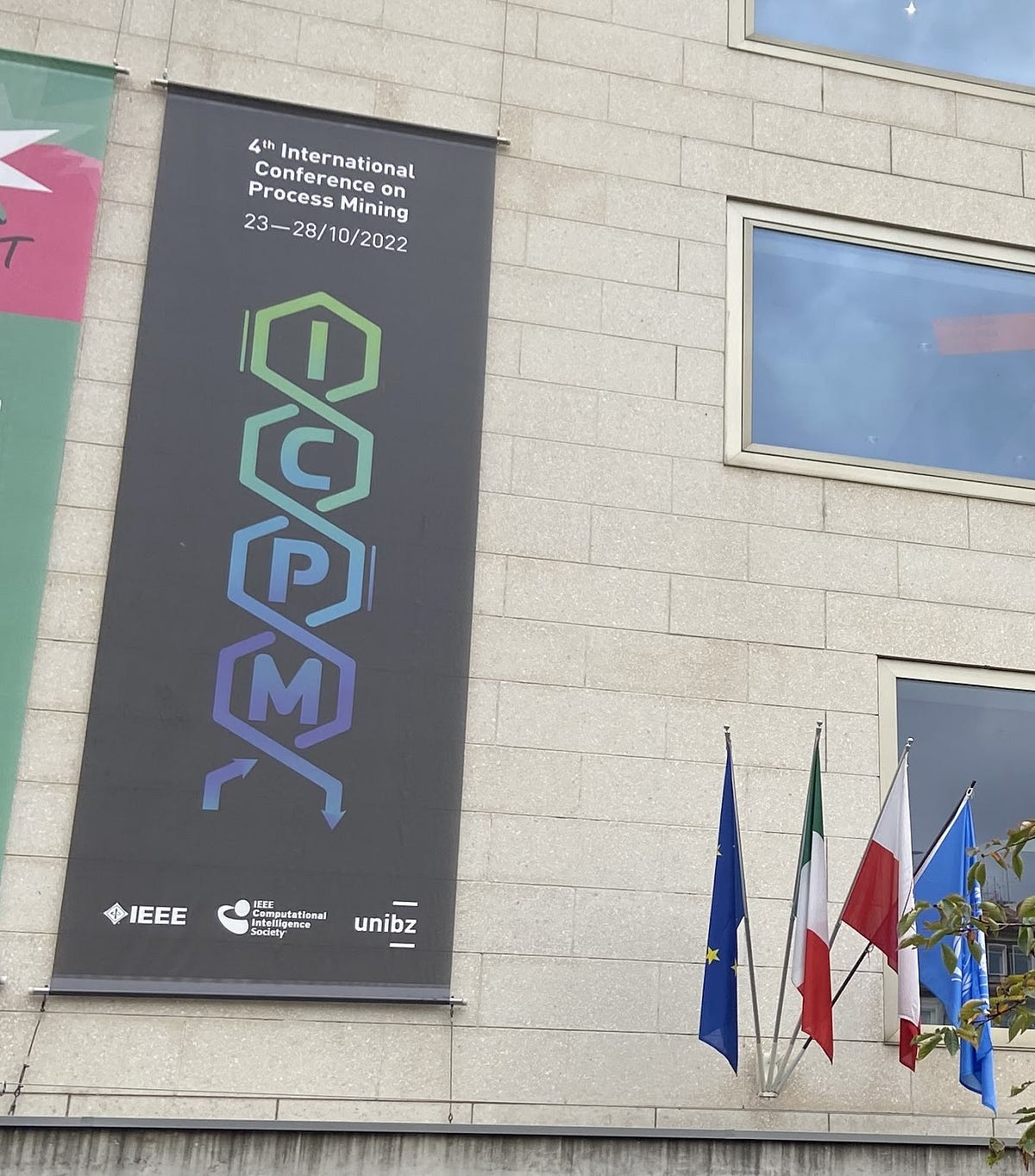Interview with Prof. Wil van der Aalst on the current state and future of Process Mining
This past October, Nour Assy, the Process Analytics team’s developer advocate, attended the International Conference on Process Mining (ICPM). ICPM is an important forum for researchers, practitioners and developers in the field of Process Mining. During the week-long conference, knowledge and recent trends in this field are shared and exchanged through scientific talks, industry discussions and technical panels.
Nour had the lucky opportunity to talk with professor Wil van der Aalst, one of the most cited computer scientists in the world, known for his work on process mining. Prof.dr.ir. van der Aalst is an Alexander-von-Humboldt professor at RWTH Aachen, heading the Process and Data Science Group (PADS) and is the Chief Scientist of Celonis.
Here we are happy to share a synthesis of their conversation about the scope of Process Mining, research advances in the field, industry adoption, and what the future holds.
Process mining, process analytics, process intelligence, and other terms are being interchangeably used. Do you see a difference in terms of scope and techniques?
Wil: Process Mining is a broad concept that ranges from data extraction and preparation to discovery, compliance and conformance checking, predictions and improvements. It is important to note that Process Mining should not be reduced to process discovery as some think. Looking at the ICPM conference topics, it is clear that Process Mining is not just about process discovery. The use of other terms is often associated with commercial reasons. So I think it would be very helpful if everyone would stick to the term Process Mining.
In the coming years, Object-Centric Process Mining will be the topic that’s going to get a lot of attention. All the vendors are going to be moving in that direction.
We are seeing a wave of Process Mining adoption in industry, and many R&D initiatives to put research ideas into practice. How do you see the current state of Process Mining in industry compared to advances in research?
Wil: Process Mining has a longer history of research and it has applications. The first tools appeared 15 years ago, but they were not very successful at doing very basic things. Right now, there are about 40 tools. I think the development of tools has accelerated in the last few years and what’s really accelerating now is the adoption in the industry. For example, Process Mining has become the normal thing to do in northern European countries. Right now, the industry is catching up, but I would say we are just at the beginning.
The transition between the basic process map view and BPMN will become more fluid. The separation that currently exists is not necessary.
The boundary between user-driven modeling and data-driven process discovery will become more fluid by following a “human in the loop” approach.
If we compare research results to commercial tools, it looks like the latter wins in terms of visualization. How do you see the future of visualization in Process Mining?
Wil: I’m not sure I agree with that statement. I think commercial tools typically have a much better usability, but they offer much more limited functionality. I think this is a big difference. In terms of visualization, I expect that process models will continue to play an important role in any type of visualization, as for example when we talk about visualizing compliance and performance data. Most importantly is that the boundary between the basic visualization of Directly-Follows Graphs (DFG) (known as process maps) and BPMN will become more fluid and I think it will become easier to switch between DFG and BPMN views. Another dimension that we will witness is that the boundary between modeling and discovery, by putting “human in the loop”, will become fluid. In the research domain, there are many prototypes of interactive process discovery in which domain knowledge can be combined with available data, demonstrating that this boundary can become fluid.
The BPMN 2.0 has become mainstream in the BPM market but it is still not that popular in the Process Mining market. Do you think there is an opportunity for a bigger adoption of BPMN in Process Mining?
Wil: The higher end tools already offer a BPMN view of the data. But as I mentioned, it is typical that the default view is a DFG, and the BPMN view is a more advanced view. So I think in the future, any Process Mining tool will support BPMN and the boundary between the two views will be more fluid. For process discovery, people usually use DFGs, while for conformance checking, they use BPMN models. You can also do conformance checking using a DFG model, and you can also discover BPMN models. That separation is not necessary. This is why I say it should become more fluid. Of course, when we talk about BPMN, we need to make it clear that if we discover things only based on the data, we are talking about a limited subset of BPMN. For example, it is possible to discover AND and XOR gateways, resources, etc., but BPMN is a rich language with many different constructs that cannot be derived from the data at this stage.
We will move from fixed and hard-coded visualization to intelligent interactive visualization. If we see bottlenecks, we will be able to click and get visualizations that explain these bottlenecks.
In the Process Mining Manifesto, there is a clear desire to combine Process Mining with Visual Analytics. Do you think we are there yet? And what challenges do you foresee in putting this idea into practice?
Wil: There are currently a few nice examples. The dotted chart is a very nice visualization which clearly complements process models. In the future, intelligent interactivity will play an important role. For example, currently, filtering based on case activity attributes is done by providing a query, pressing buttons or exploring a hard-coded dashboard. I expect this to become more fluid. For example, users will be able to click on bottlenecks and have visualizations that explain these bottlenecks. We don’t see those capabilities right now, but it’s clear that with smart visualization, you could do simple things like bar charts, but also dotted charts and other advanced visual components.
Currently, we discover and use 2D process models. Are we going to move on to 3D models?
Wil: This reminded me of the time when I used to visit Australia. We have developed a ProM plugin that allows us to visualize a process in 3D and walk through it in virtual reality. I think 3D visualizations are nice and get people’s attention, but adding a third dimension can quickly become limiting and we should be careful about that.
In addition to the obvious use cases in BPM and Process Mining technologies, there are many other situations where process-related execution data needs to be visualized (RPA, BI, test automation, CI/CD pipelines). Do you think Process Mining technologies will start to offer these capabilities as part of their solutions?
Wil: Let’s take the example of RPA and Process Mining. There is a clear relationship. The RPA part generates the events based on screen scraping or whatever is used. So the RPA will provide event data. Then for a Process Mining tool, this is not new. I think it’s also true for many other application areas. The requirements for Process Mining are not so different. That’s why we see increasingly that, for example, Process Mining is used in production. Previously, it was mainly financial and administrative processes. For Process Mining, I think the challenges are more on the data preparation side. For example, how do you convert sensor data into event data? But I would consider that this is actually something that is outside of what you would expect from a normal Process Mining tool.
In the opening session of ICPM 2022, we saw words like “prediction” and “alignment” in the top topics of the word cloud of ICPM 2022. What words or topics do you think will appear in the word cloud of ICPM 2030?

Wil: That is difficult. But in the coming years, the topic that’s going to get a lot of attention is Object-Centric Process Mining. I think there is a lot of research going on in this area and all the vendors are going to be moving in that direction. If you think a bit further, it is not so clear what it would be. What I find fascinating is that even though we have good techniques for process discovery, compliance checking, prediction, etc. some of which work in practice, however, it’s clear that these problems are not solved. So I predict that in 2030 we will still be talking about process discovery techniques, because it is a very difficult problem that requires years of follow-up.

